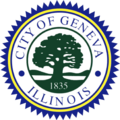Geneva, Illinois | |
|---|---|
City | |
 Geneva City Hall as viewed from Illinois Route 31 | |
 Location of Geneva in Kane County, Illinois | |
| Coordinates: 41°53′00″N88°19′27″W / 41.88333°N 88.32417°W [1] | |
| Country | United States |
| State | Illinois |
| County | Kane |
| Township | Blackberry, Geneva, St. Charles |
| Founded | 1835 |
| Incorporated as a village | 1867 [2] |
| Incorporated as a city | 1887 |
| Government | |
| • Type | Council-Manager |
| • Mayor | Kevin Burns [3] |
| Area | |
• Total | 10.20 sq mi (26.43 km2) |
| • Land | 9.97 sq mi (25.81 km2) |
| • Water | 0.24 sq mi (0.62 km2) |
| Elevation | 738 ft (225 m) |
| Population (2020) | |
• Total | 21,393 |
| • Density | 2,146.7/sq mi (828.84/km2) |
| Time zone | UTC-6 (CST) |
| • Summer (DST) | UTC-5 (CDT) |
| ZIP Code | 60134 |
| Area codes | 630 and 331 |
| FIPS code | 17-28872 |
| GNIS feature ID | 2394875 [1] |
| Website | geneva |
Geneva is a city in and the county seat of Kane County, Illinois, United States. [5] It is located in the far western side of the Chicago suburbs. Per the 2020 census, the population was 21,393. [6]
Contents
- History
- Geography
- Demographics
- 2020 census
- Arts and culture
- Sports
- Education
- Elementary education schools
- Middle schools
- High schools
- Media
- Infrastructure
- Transportation
- Notable people
- References
- External links
Geneva is part of a tri-city area, located between St. Charles and Batavia. [7] [8] The area experienced rapid population growth from the late 1980s through the mid-2000s as the Chicago suburbs spread to the west.
Geneva is located along the Fox River. Portions of the Fox River Trail and the Illinois Prairie Path pass through Geneva. The Fabyan Windmill, a Dutch windmill dating from the 1850s, is located here.







